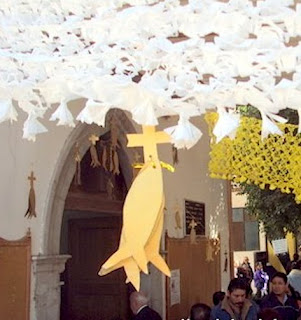For another in our occasional posts on the distinctive portrayal of certain saints in Mexico we consider the medieval Dominican Blessed Gonzalo de Amarante.

Gonzalo then entered the Dominican Order, living as a hermit and performing good works including the building of a bridge over the treacherous waters of the nearby Tamega river. He commanded fish to leap from the river to feed the hungry laborers. Many other miracles were attributed to him, including the alleviation of illness, infirmity and hunger among the poor.
Reflecting this history, the saint is usually portrayed in the Dominican habit, holding his pilgrim's staff and often a string of fish.*
After his death, a tradition grew up of chanting* and dancing before his image, especially among poor women supplicants seeking fertility. This custom spread to Mexico where modest chapels to San Gonzalo sprang up, often in working class or indigenous barrios in outlying locations. But by late colonial times the practice of dancing to San Gonzalo, known as El Bailador (The Dancer), grew so popular among the urban poor and marginalized, taking place even in front of major Dominican churches—that it was seen by the Bourbon officials and church authorities not only as impious and vulgar but as a potential threat to public order, and was increasingly restricted.
Although, as official inquisitors, the Dominicans were charged with banning such practices, the fact that San Gonzalo was a popular Dominican saint persuaded them to often turn a blind eye to the dancing, which has survived until recent times in a few places notably in Guadalajara and Guanajuato.
San Gonzalo Salamanca (Guanajuato) native dancer and fish banners
In these locations, festivities accompany the saint's day on January 10 with music and dancing.
altar of San Gonzalo (in Mellado, Guanajuato) with statue of the saint, harp, drums and guitars
* Traditional Mexican appeal: "San Gonzalo de Amarante, que sacas pescado del mar, sacame de este cuidado, que y a te vengo bailar" "St. Gonzalo, who draws fish from the water, rid me of this care so that I may dance before you."
* Several other saints are portrayed with fish, notably the Archangel Raphael, Sts Francis and Anthony of Padua, as well as more obscure figures like St. Blaise and St. Benno.
text © 2020 Richard D. Perry. images by the author, Benjamin Arredondo and online sources.
visit our earlier posts on other Mexican images of uncommon saints:






No comments:
Post a Comment